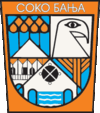Sokobanja
| Sokobanja Сокобања | ||
|---|---|---|
| Municipality and Town | ||
|
| ||
| ||
 Location of the municipality of Sokobanja within Serbia | ||
| Coordinates: 43°39′N 21°52′E / 43.650°N 21.867°ECoordinates: 43°39′N 21°52′E / 43.650°N 21.867°E | ||
| Country |
| |
| District | Zaječar | |
| Settlements | 25 | |
| Government | ||
| • Mayor | Dimitrije Lukić (DS) | |
| Area[1] | ||
| • Municipality | 525 km2 (203 sq mi) | |
| Population (2011 census)[2] | ||
| • Town | 7,972 | |
| • Municipality | 15,981 | |
| Time zone | CET (UTC+1) | |
| • Summer (DST) | CEST (UTC+2) | |
| Postal code | 18230 | |
| Area code | +381 18 | |
| Car plates | ZA | |
| Website |
www | |
Sokobanja (Serbian Cyrillic: Сокобања, pronounced [sɔ̂kɔbaɲa]) is a spa town and municipality situated in eastern Serbia. In 2011 the population of the Sokobanja town is 7,972, while population of the whole municipality is 15,981.
Sokobanja is one of the most popular tourist resorts in Serbia. It is situated in the southern part of Sokobanja valley, surrounded by mountains Ozren, Devica, Janior, Rtanj and Bukovik. The Moravica River runs through Sokobanja. It creates a canyon just 2 km before entering the town. Remains of the Roman and later medieval Serbian fortress Sokograd stand today near the canyon of Moravica. Lake Bovan is situated some 10 minutes of drive to the west of Sokobanja. It is especially popular among fishermen. Special hospital for lung diseases is situated on Ozren mountain. Town center of Sokobanja is home to the 16th-century Turkish baths and 19th-century buildings of elementary school, Milošev konak and Serbian Orthodox church.
Soko Grad (Соко Град), also known as Sokolac, was a medieval city and fortress 2 km east of Sokobanja. The fortress was declared a Monument of Culture of Great Importance in 1982, and it is protected by Republic of Serbia.[3] The fortress was founded in the 6th century during the reign of Emperor Justinian I, to prevent incursions of Pannonian Avars and Slavs into the Balkan peninsula. In 1172, it was occupied by Stefan Nemanja and became part of the medieval Serbian state. The Ottoman Empire occupied it in 1398. The town was destroyed by the Ottomans during a conflict, and today the only visible remains of the upper town are the gate, walls, and three towers.
 Waterfall at Ozren mountain.
Waterfall at Ozren mountain. Overview of Sokograd.
Overview of Sokograd.
See also
References
- ↑ "Municipalities of Serbia, 2006". Statistical Office of Serbia. Retrieved 2010-11-28.
- ↑ "2011 Census of Population, Households and Dwellings in the Republic of Serbia: Comparative Overview of the Number of Population in 1948, 1953, 1961, 1971, 1981, 1991, 2002 and 2011, Data by settlements" (PDF). Statistical Office of Republic Of Serbia, Belgrade. 2014. ISBN 978-86-6161-109-4. Retrieved 2014-06-27.
- ↑ Monuments of Culture in Serbia: СОКО ГРАД (SANU) (Serbian) (English)
| Wikimedia Commons has media related to Sokobanja. |



